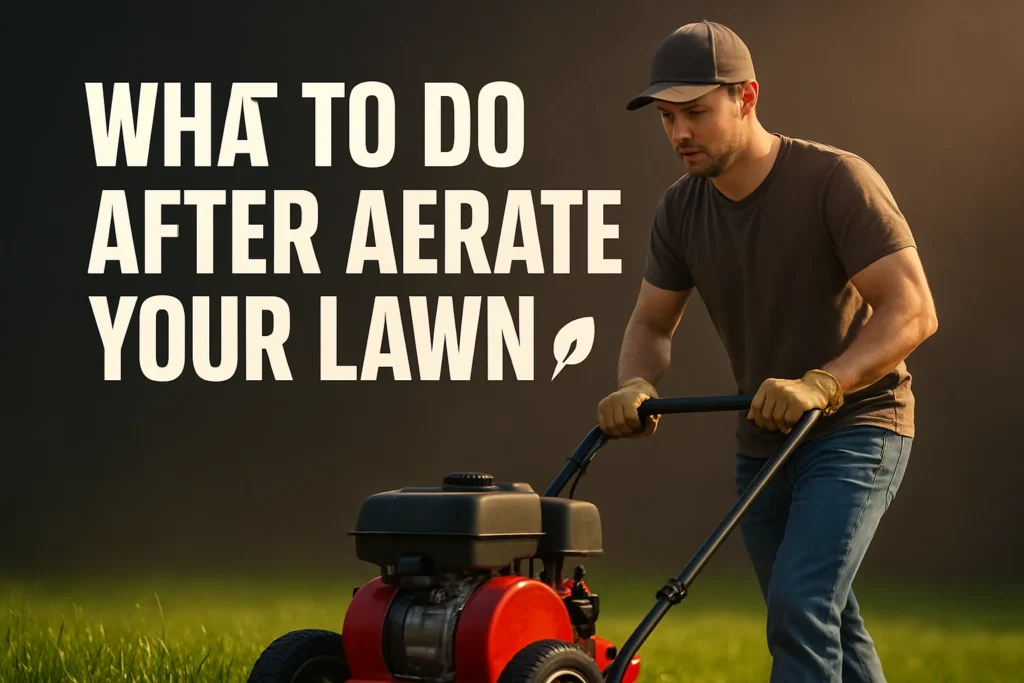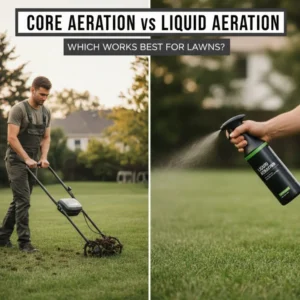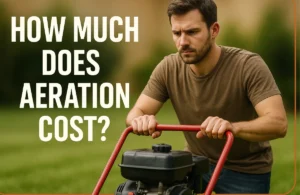Aeration promotes airflow, water and nutrient movement toward grassroots. Then what do you do after aerating the lawn? After that, the soil and grass demand appropriate attention to allow recovery and the ability to mow when and how you should. Nevertheless, resisting many feet walking on it during the recovery period is important to stop the freshly aerated soil from being compacted. Here’s the complete guide on what to do after aerating your lawn.
Things You Need To Follow after aerating your lawn
Lawn aeration is a vital lawn care practice used to ensure a healthy soil system through soil puncturing. These holes allow air, water and nutrients down to the root zone, resulting in stronger root growth and a healthier lawn. But aerating is only one step — what you do next can make a big difference in the impact of aerating your lawn.
Leave the Soil Plugs (Cores) Alone
If you used a core aerator, you will see soil plugs on the soil surface. These plugs are best left alone, however, as they simply disintegrate and put decomposed organic matter and beneficial microbes back into the soil. These little guys break down thatch and improve soil health. Drinking plugs out does neither of your bodies any harm.
Overseed Your Lawn Immediately
Aeration loosens the soil, allowing for excellent conditions for overseeding. Applying lawn seed after aeration enables seeds to fall into the holes in the soil, resulting in higher germination rates and thicker, fuller grass. Seeding is especially helpful for filling in bald spots and achieving lawn thickness. Just be aware that your timing will depend on the type of grass you have:
- Cool-season grasses: Preferably reseed in early fall or when soil temperatures reach the range of 50-65°F.
- Warm-season grasses: Sow in late spring or early summer when the soil temperature has reached 70°F.
Water Your Lawn Properly
Care watering should be performed after aeration and overseeding. The soil is loose and quickly dries, so water right after aerating.
- Try to water deeply so that at least 6″ of soil is wet.
- Give the new grass some water after it’s been put down.
- Then water lightly but frequently (3-4 times a week) to keep the soil moist
It assists in seed germination and root growth. Keep up with this watering regimen for at least a couple of weeks, as it usually takes 10-15 days for grass seed to germinate.
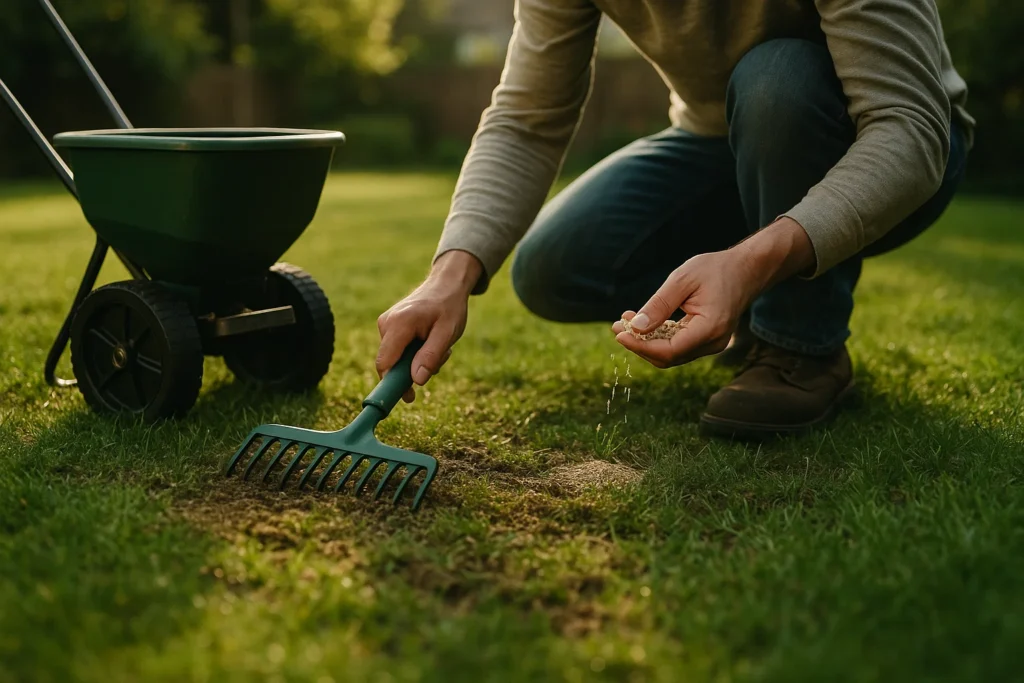
Apply starter fertilizer for grass
Fertilizing after you have aerated the soil is beneficial to your lawn as it enables nutrients to penetrate the grass roots via the aeration holes. Feed using a good, slow-release, high-quality fertilizer that gives you a well-balanced feeding over time. It promotes a healthy root system, which will benefit the new grass when it seeds.
Mow Your Lawn at the Right Time and Height
Do not mow your yard right after you have aerated and overseeded it. Wait 2 to 4 weeks before mowing to let the grass grow. And when you do cut, adjust your mower to the right height according to your type of grass:
| Grass Type | Mowing Height After Aeration |
| Warm-season grass | 2 to 2.5 inches |
| Cool-season grass | 3 to 4 inches |
Tip: Do not remove more than one-third of the grass length in one cutting to avoid stressing the grass.
Avoid Heavy Traffic on the Lawn
The holes that aeration makes must have time to heal and become compact. The lawn and its soil structure can be damaged by pedestrian traffic, parking vehicles, equipment, and machinery within the several weeks following seeder application and lawn recovery. Keep traffic to a minimum for a couple of weeks after aerating to enable the lawn to mend effectively.
Lawn Plugger and Core Aeration
Both of these are related techniques that can aid your lawn in both reducing soil compaction and allowing air, water, and nutrients to flow better to the grass roots. Both of these consist of making holes in the soil, but they do so in different ways and to a different level of soil disturbance. Knowing the distinctions allows homeowners to decide on the best option for their lawn.
What Is a Lawn Plugger & How Does It Work?
A lawn plugger is a type of aerating tool that is designed to remove small plugs or cores from the grass. Hollow tines are used to remove these plugs, which are usually about ½ – ¾ inch in diameter. By extracting these plugs, the lawn aerator opens up the soil and reduces compaction to let oxygen, water, and nutrients reach the root of your grass! The plugs are left to decompose on the surface, adding organic matter to the soil. Lawn pluggers are good for lawns with medium to heavy compaction and can be utilized on larger areas or higher traffic lawns.
Plugger vs. Core Aeration: Which Should You Go With?
The two terms are used interchangeably, but core aeration typically means pulling soil plugs with hollow tines – that’s what a lawn plugger does. But there are certain differences, depending on your plug size and your kind of equipment.
| Feature | Plugger (Core) Aeration | Spike Aeration |
| How It Works | Removes small plugs (cores) of soil using hollow tines | Pokes holes by pushing solid spikes into the soil without removing soil |
| Soil Compaction Relief | Highly effective; remove soil plugs and loosen soil | Less effective; can sometimes worsen compaction by compacting soil around holes |
| Hole Size and Depth | Creates larger, deeper holes | Creates smaller, shallower holes |
| Best Lawn Size | Ideal for medium to large lawns | Better suited for small lawns or mildly compacted soil |
| Soil Types | Works well on clay, rocky, or heavily compacted soils | Best for sandy or loose soils with mild compaction |
| Frequency Of Use | Usually needed once every 1-2 years due to thorough aeration | May require more frequent aeration because of limited soil loosening |
| Equipment Type | Mechanical, often gas-powered or tow-behind; some manual versions available | Often, manual or lightweight tools. |
| Time and Effort | More time-consuming and labor-intensive. | Less time-consuming, but less effective for severe compaction |
| Cost and Availability | Usually requires renting or buying specialized equipment, higher cost | Generally cheaper and easier to perform yourself with simple tools |
Tip: For most homeowners seeking lasting lawn health improvements, core aeration with a lawn plugger is the recommended method.
How Long After Aerating Can You Mow?
Typically, watering and mowing can be resumed 2-4 weeks after aeration, once the grass has recovered and shows new growth. This time interval gives the grass a chance to grow into the holes and develop deep roots without being irritated by a premature mowing.
Signs Your Lawn is Ready for Mowing
- Grass shoots have reached a healthy height for your grass type (generally about 3-4 inches for cool-season, 2-3 inches for warm-season).
- The soil plugs have mainly broken up or sifted into the lawn.
- New grass seedlings from overseeding have developed sufficiently to be mowed.
How Aeration Affects Lawn Growth
Aerating helps relieve soil compaction and allows air, water, and nutrients to penetrate your lawn’s roots. This helps to create stronger roots, thicker turf, and increases resistance to drought and disease. Faster grass recovers – Improved soil conditions also encourage the grass to recover more quickly and create prime growth conditions after aeration.
Mowing Dos and Don’ts Post-Aeration
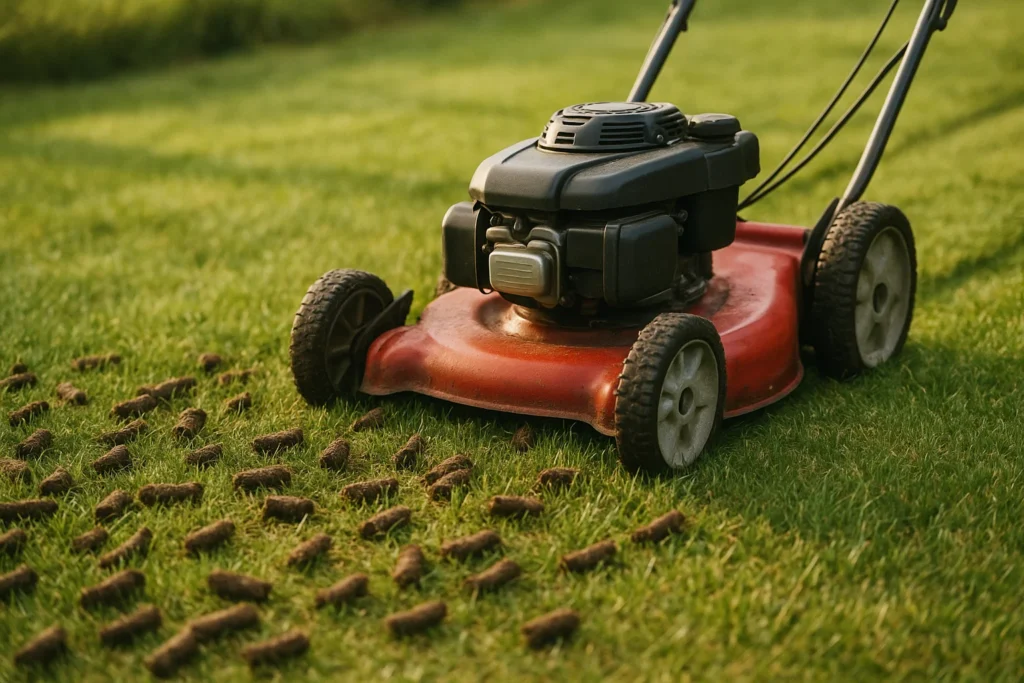
Dos:
- Do not mow until at least 2 weeks have passed.
- Never use a dull mower blade as it tears the grass.
- Mow by the appropriate height for the type of grass you have.
- Mow dry grass to avoid soil compaction.
Don’ts:
- Don’t mow immediately after aeration.
- Never remove more than one-third of the grass blade growth at one time.
- Do not use heavy equipment on the lawn or encourage excessive foot traffic until the lawn has recovered.
What To Do After Lawn Aeration
Well, you have just aerated your lawn, and that is great! One of the most effective means of enhancing soil health and increasing the growth of grass is aeration. It aerates the ground and makes the soil accessible to air, water, and nutrients deep in the root zone. Aerating is not a complete solution, though. After aerating, there are other measures that one must take to ensure that the lawn recovers fast and grows more robust than ever before.
This is how to follow up after lawn aeration:
Leave the Soil Plugs Alone
After aerating, you will see small pieces of soil- also known as plugs- all over your lawn. There is nothing wrong with that! These are the plugs that are removed as you aerate your lawn, and they are in fact, beneficial to your lawn.
Why leave them?
- They decompose with time, releasing valuable organic matter to the soil.
- They have helpful microbes that help in soil structure and the breakdown of thatch.
- There is no need to remove them at all, and this does not offer any value.
Overseed Your Lawn Immediately
Aeration provides ideal growth conditions to the overseeding procedures since the soil opens up and becomes less compact, resulting in direct seed-soil contact. This significantly enhances germination rates and helps cover up thin or bare areas.
Steps to overseed after aeration:
Select a suitable seed: Select a seed of a type that fits your current lawn and the climate of that area (cool-season or warm-season grass).
Spread evenly: A broadcast spreader can be used on large lawns, whereas a hand spreader is good on smaller areas.
Lightly rake: Once the seeds are sown, lightly rake over the seeded area so the seeds land in the holes made by aerating
Water Your Lawn Deeply
Aerating is followed by one of the most crucial procedures- watering. It now loosens up the soil and makes it more absorbent, implying that the water is able to reach the roots quickly.
How to water after aeration:
Start immediately: Water your lawn well after aerating (and overseeding, if you aerated) as soon as possible.
Depth of water: It should be aimed at wetting the top 6 inches of soil. This makes the soil settle, and it also enhances root growth.
Watering: The following two weeks, water the newly-planted shrub sparingly but often (about 34 times a week) to make the soil constantly moist.
Stay Off the Lawn
After aerating your lawn should have time to recover, especially when we overseed. Constant foot traffic or parking equipment on it may compact the soil back into it and kill delicate plantations.
How long should you avoid traffic?
- At least 2- 3 weeks: It would allow the soil time to recover and the seeds to sprout.
- Signs it’s safe: The first thing to do is to wait until you see the grass growing in your yard and it is approximately an inch or so tall (within the range of being approximately 3 inches tall), it is essentially sound to walk on.
Additional Tips
- Topdressing: A few lawn care professionals suggest spreading a thin layer of compost or sand on the lawn after aeration to level it out and enhance the quality of the soil.
- Dethatching: If you have a thick layer of thatch in your lawn, it’s good to dethatch before aerating to prevent unnecessary strain on the aerator, though it’s not always needed.
- Water before aerating: Watering your grass 1 to 2 days before aerating loosens your soil and makes aerating more effective.
Conclusion
Lawn aeration is the best way to promote soil health and grass growth, yet this is only half the equation. For best results, immediately overseed, deep and frequent water, fertilize with a good quality slow-release fertilizer, mow gently after 2-4 weeks, and keep heavy traffic off your lawn. Taking these steps will contribute to your grass recovering faster, growing thicker, and becoming greener.
Rely on Revamping Lawns for expert care and solutions that bring out the best in your lawn. Contact us to get started.
FAQs
No, the best thing to do is to let the plugs decompose on the lawn where they will naturally break down and provide many benefits to soil health.
You should water the lawn right after you have aerated and continue to water lightly 3-4 times a week for a minimum of two weeks.
Wait for new grass to establish, which usually takes about two to four weeks before you can start mowing.
Yes, it is best to aerate and then overseed for good seed-to-soil contact and to help increase germination.
Most lawns do not need aeration more than once per year, but heavily used lawns or those growing on heavy clay or subsoils may need it twice per year.

